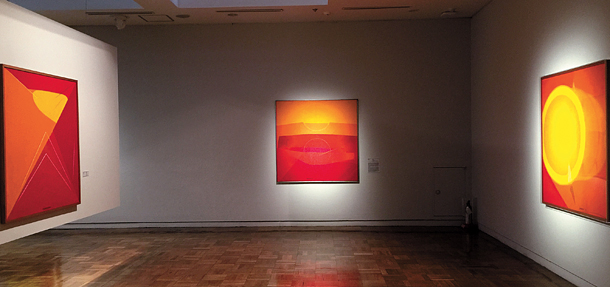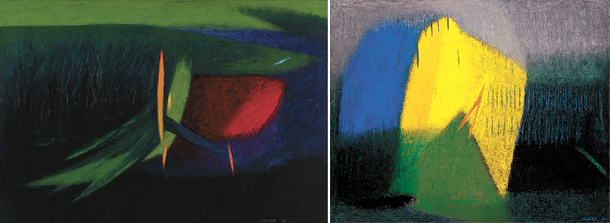The boldest colors of Korean abstract art : New exhibit celebrates artist Yoo Youngkuk’s multicolored oeuvre

The largest-ever retrospective of Yoo Youngkuk (1916-2002), one of the leading pioneers of Korean abstract art, runs through March 1st at the National Museum of Modern and Contemporary Art (MMCA)’s branch in Deoksu Palace in central Seoul. His “Circle” series, above, are pure abstract paintings but remind the viewers of the sublime spectacles of the sunrise and the changing landscape during the sunrise. [MOON SO-YOUNG]
“If I, a Korean, can create a painting that no one in the world had created before, the painting will be the art of Korean identity,” the artist would say, according to his son Yoo Jin, a scientist and emeritus professor at Kaist.
The son was at the press preview of the “100th Anniversary of Korean Modern Master: Yoo Youngkuk,” the largest-ever retrospective of the artist, last week. The show runs through March 1st at the National Museum of Modern and Contemporary Art (MMCA)’s branch in Deoksu Palace, central Seoul.
In accordance with Yoo’s remark, about 100 pieces of his paintings on view at the exhibition show both cosmopolitan qualities and the artist’s personal characteristics with their unique color schemes and geometric shapes.
Although they are all abstract paintings, they are “reminiscent of the deep water, rugged mountains, clear valleys, and red sun of his hometown Uljin, North Gyeongsang province,” as Kim In-hye, curator of the exhibition, pointed out.
Yoo once wrote in a note that, “The subject of my oeuvre is nature, which I have explored through non-figurative forms. That is abstraction. It is nature, not as a particular subject, but as lines, planes and colors.”
“The power of Yoo’s abstract aesthetics lead the viewer to approach the essence of nature even more directly than figurative paintings do,” Kim said.

Yoo’s abstract paintings “Work”(1964), left, and “Work”(1965) show relatively soft and relaxed forms and the rich primary colors of red, blue and yellow along with green, which were characteristic of his paintings in the early 1960s. The colors are full of light and resonating qualities. [MMCA]
“As Cezanne went to Mount Sainte-Victoire everyday to paint it, Yoo recalled the mountains in his hometown of Uljin in his mind again and again for his paintings,” said Tiffany Yun, senior deputy director of public relations at the MMCA.
And Yoo expressed his respect for Dutch abstract artist Piet Mondrian, who sought to express the fundamental and unchangeable beauty and truth lying beneath nature’s complicated forms and colors through grids of black lines, the three primary colors and white space.
The exhibition, which consists of five sections, shows how Yoo’s paintings evolved over time.
The highlight is the two sections that feature his paintings from the 1960s, which are regarded as the peak of his oeuvre.
Viewers can see Yoo’s abstract paintings had relatively soft and relaxed forms and rich primary colors, along with green and violet. And later in the 60s, the irregular forms of his paintings gradually advanced into stricter geometric shapes.
Twenty of Yoo’s paintings on view can also be seen as ultra-high resolution images at the Google Art and Culture site. (https://www.google.com/culturalinstitute)
BY MOON SO-YOUNG [symoon@joongang.co.kr]
Admission is 3,000 won ($2.50) for adults. It includes the Deoksu Palace admission, which is 1,000 won. The palace is closed on Mondays. Go to Seoul City Hall Station, line No. 2, exit 10 and walk for five minutes.
For more information visit www.mmca.go.kr or call (02) 2022-0600.










with the Korea JoongAng Daily
To write comments, please log in to one of the accounts.
Standards Board Policy (0/250자)